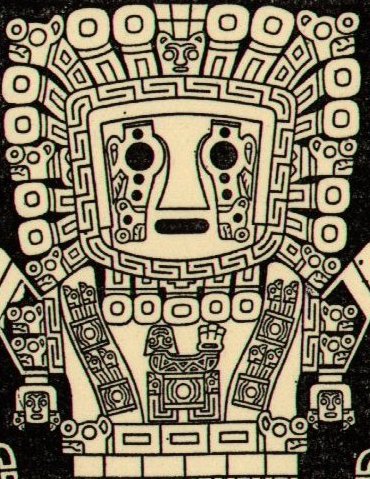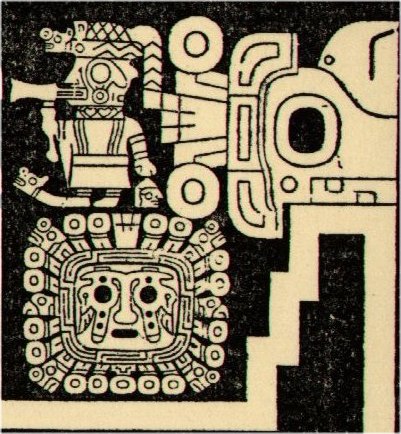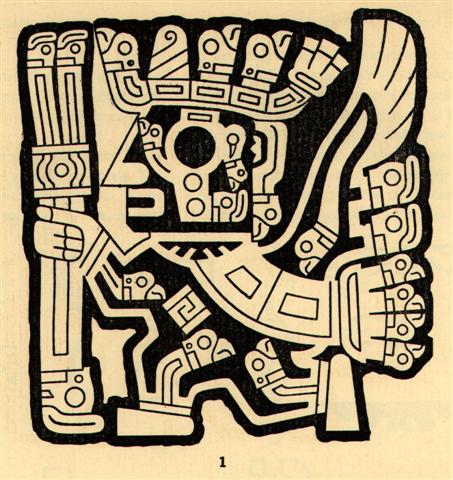|
TRANSLATIONS
Side b begins with viri (GD33):
The glyph sequence Ab1-14--20 has a parallel in Aa4-12--18. These 7 parallel glyphs give us a clue to read Ab1-1--13 together as one part. Metoro seems to have read Ab1-1--13 as two parts, because capital letters are found not only at Te hoea (because a new line is beginning with Ab1-1) and at Rei in Ab1-5 (Rei with capital letter is normal for Metoro), but also at Ab1-8 with: Ko te maitaki - ko te maharoga The first of these two parts has 7 glyphs and the second 6 glyphs. 20 then arrives as the result of counting 7 + 6 + 7. This sequence of alternating 7 and 6 then continues beautifully with another sequence of 6 glyphs from Ab1-21 up to and including Ab1-26, at which point (of course) a natural stop occurs; which also is to be read by way of the hatch-marked henua:
Why is viri the first glyph on side b and what did Metoro mean with te hoea? In order to answer these questions we should begin by repeating earlier thoughts. First we must recapitulate from the prelimary GD33 (viri) item in the glyph dictionary:
This is not the place to question what once was written, e.g. the suggestion that Matariki i raro coincides with the beginning of side b; suffice it to say that much remains relevant. A new reflection occurred to me, while once again reading about the 5 friends of Kuukuu waiting for him to recover during 3 days: 'The five kept watch - one day, two days, three days.' The curious circular black spots in the face of the sun god in the Gateway of the Sun possibly indicate the 'dark' nights outside the regular 360 days:
Counting, from the bottom and beginning with the black eye of the puma, the sun god's great eye arrives as number 4. Then follows one more black spot and the sequence ends with a black rectangular mark like a bar. I guess this means that after 360 there follows 5 'dark' nights (black spots) and the 4th of these coincides with the death of the old sun (year), i.e. where the arrival of the 364th night closes the moon year. The old fire is put out in the 364th night. Kuukuu had 5 friends and the leap year has an additional night, therefore there must be one more than those 4 surrounding the great 'Kuukuu' black spot. "... Hoapili was so much in the habit of observing these [the 5 planets] that he could at any moment tell the position of each; ... he had heard from others that there was one more travelling star, but he had never recognized it, and was acquainted with only these five ..." (Heyerdahl 6 quoting Fornander quoting Dibble.) The 5 'otters' trying to steal the fish from the barbecue grill presumably means the 5 planets trying to rob the sun (the fire) from his silvery 'fish' (the moon). The robbery surely is staged to occur during the 'dark' night when sun is absent. Earlier I have toyed with the idea that the 3 days in waiting are to be read in Aa1-13--14:
For the moment I tend to read the left part of Aa1-15 as the beginning of the new period (GD29, oho), and in that case the gap in the middle of the glyph could correspond to the black stop bar in the face of the sun god at Tiahuanaco. The new year seems to start to emerge in the night after the great black spot, perhaps meaning that at the moment of 'birth' it is dark. 'Light' (order) appears one night later, after jumping over the 'ditch' (the 'stop bar', the interval between the left and right parts of Aa1-15). The fire is stamped out in the 364th night. In the 365th night there is no fire. I am aware of the fact that in the lesser sun faces seen in the Gateway of the Sun there are fewer black spots:
The month signs (example at left above) have just 4 black spots. The place of the missing bottom one (the eye of the puma) is taken by a 'cup of light'. Maybe the idea is to show that there are 4 extra ('dark') nights beyond the end of the 360-day solar calendar (after which also the moon calendar reaches its end). The day signs (example at right above) have only 3 spots and just 1 of them is black. Maybe we should understand that just in one day of the year the fire is absent. Though, that does not explain why there are 2 light spots. Possibly the spots refer to the diurnal cycle - the light spots being a.m. and p.m. while the night looks the same both before and after midnight. There are only 4 uncomplicated viri glyphs in Tahua, two on side a and two on side b. Two of them (Aa8-26 and Ab7-26) probably are marked by their ordinal number in the line (26). Are they positioned at points where seasons are 'finished'? As a8 is the last line on side a the question seems relevant. On side b there are also 8 lines, but here the viri glyph is located in line b7. Does that indicate that line b8 should be regarded as a mirror image of line a1 - a line which is special, located outside the rest of side b? Aa8-26 we have earlier found located just before rebirth: ... If - as I have suggested - GD34 signals the death-and-rebirth of the king (together with lightning hitting the earth and thunder rolling), then the last line of side a seems an approriate location. The surrounding glyphs do not contradict this idea:
At Aa8-26 (notice 26) we find viri, the 'clew' or 'corner of the sail', in Aa8-28--29 we see an arrangement reminding us about the back-to-back lions of Egypt, marking transfer of rulership to the next period (7 + 7 = 14 marks) and in Aa8-30 the sun may be in hua phase. In Aa8-31 we at right find a 6-marked figure, somewhat similar to Aa1-41 and parallel glyphs (arriving just before midnight):
Is this shape a child not yet born? Ab7-26 we have met too, in comparing with the midsummer glyphs. A long quotation may be necessary: ... In Aa5-4--7 we can read diminishing light (Aa5-5):
Aa5-5 is not in the dark season of the year (black below), but the glyph seems to initiate the 3rd and last period of the year:
In Aa5-4 the bottom part of GD37 also may signal diminishing light, being thinner than the upper part. If I eliminate the hatch-marked glyphs (22) from the total 134 glyphs which I have catalogued as belonging to GD37 there remains 112 glyphs. One of these, Ab3-26, seems to be black:
Among the remaining 111 we find a great variability. Even the 68 glyphs which appear to be without 'contamination' from other GD are variously formed:
As can be seen there are 3 glyphs (Aa4-42, Aa5-4 and Aa5-36) which are alike (redmarked above), presumably indicating a continuation of a theme. We notice 42 and 36 again, this time surrounding number 4. Possibly number 4 is also alluded to in the rhomboid shape suggested by the legs in Aa5-6:
Though this is not obvious, since I have not seen it earlier - Aa5-6 is not listed among the GD53 glyphs. As the forefinger (?) is free from the rest of the glyph we should read the sign '1', especially as it is not bent like the rest of the fingers. From the internal parallel glyphs (Ab7-24--26) - note the numbers 24 and 26 - it appears indeed that there should be a hole between the legs in Aa5-6:
We also understand that the triplet on top of the head in Ab7-25 suggests hau tea. To understand Ab7-25 we lean on Aa5-5--6 and to understand Aa5-6 we lean on Ab7-25. In Ab7-25 the 'fruit' (hua) stems from the thumb (the normal pattern), whereas in Aa5-6 it appears as if the origin is the middle finger. Maybe GD33 (viri) - as here seen in Aa5-7 and Ab7-26 - alludes to GD24 with both holes open? So we have the 4 uncomplicated viri glyphs located at the beginning of side b (Ab1-1), respectively just before rebirth (Aa8-26) and at the solstices. That is the suggestion. Summer is indicated in Aa5-5 (by way of the 'open roof') at the same time as diminishing light is evident (in the way the 'vertical rays' become shorter towards right). In Ab7-25 hau tea may be alluded to as if growing from the head, a reasonable sign if the new year is 'around the corner'. There are just 2 solstices in a year, but there are 4 (uncomplicated) viri glyphs. Why 4? How do we know that viri ('the corners of the sail') does not mean a cardinal point in general? We have clear evidence telling us that Aa5-5 and Ab7-25 appear at the two solstices. Could then Ab1-1 and Aa8-26 refer to the equinoxes? While Ab1-1 indeed could refer to autumn equinox (the time when the old agricultural year 'leaves' and a new year must be 'born'), after which the winter ruled by the moon is to be described. The rule of the sun is on side a and the rule of the moon is on side b. But Aa8-26, we have found, is located in the 5th part of the 5-fold division of the year:
We have, though, not investigated line a8 and cannot have any opinion about the matter. Let us therefore take a quick look at the structure of this line. Line a8 is punctuated by the 7 occurrences of the glyph type seen below in the table, and why couldn't, therefore, line a8 be a calendar for the week:
This is just a quick guess and of course needs further study. But we immediately can see in the supposed 'Sunday' sequence of glyphs (1 + 7) a beginning which resembles Sunday in the H calendar:
If this new idea holds true, then Aa8-26 will be located in Tuesday, the day of Mars. The variable red light connected with this far traveller could indeed be in need of viri to mark the extreme points of maximum and minimum visibility. |
|||||||||||||||||||||||||||||||||||||||||||||||||||||||||||||||||||||||||||||||||||||||||||||||||||||||||||||||||||||||||||||||||||||||||||||||||||||||||||||||||||||||||||||||||||||||||||||||||||||||||||||||||||||||||||||||||||||||||||||||





























